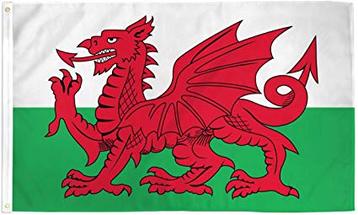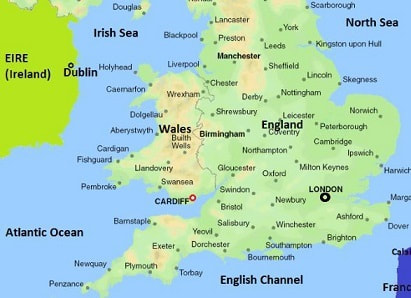Wales (Cymru)

Wales is a beautiful place. Rugged mountains and sea coast. Every bit as green as Ireland and even more sheep grazing beautiful pastures. The land area is roughly the size of New Jersey. The population is about the same as that of Arkansas. Of the 3 million people who live in Wales, about 800,000 claim some skill in the Welsh language. That figure is 27% of the 2011 population of Wales. The Celtic language of Wales is brittonic and is the only Celtic language that is not identified by UNESCO as "endangered". There are more active Celtic speakers in Wales than any other place in the world.
Authoritative, written accounts of traditional Welsh music date back to 1194 CE. The author was Giraldus Cambrensis. He toured Wales in 1188 and identified the harp, crwth and pipes as the principle musical instruments of the region. Cambrensis’ 1194 book has one passage that has caused much debate among scholars. His writing indicates that harmony singing (polyphony is the technical term) was well established throughout Wales. Musicologists have long held that polyphony originated at Notre Dame Cathedral in Paris. Those Parisian compositions date no earlier than 1180 CE. At the very least polyphony, one of the most important developments in Western music, happened simultaneously in Wales and Paris. Perhaps it happened earlier in Wales. History reveals that the medieval musicians of Wales were every bit as sophisticated and innovative as their much celebrated contemporaries in continental Europe.
Authoritative, written accounts of traditional Welsh music date back to 1194 CE. The author was Giraldus Cambrensis. He toured Wales in 1188 and identified the harp, crwth and pipes as the principle musical instruments of the region. Cambrensis’ 1194 book has one passage that has caused much debate among scholars. His writing indicates that harmony singing (polyphony is the technical term) was well established throughout Wales. Musicologists have long held that polyphony originated at Notre Dame Cathedral in Paris. Those Parisian compositions date no earlier than 1180 CE. At the very least polyphony, one of the most important developments in Western music, happened simultaneously in Wales and Paris. Perhaps it happened earlier in Wales. History reveals that the medieval musicians of Wales were every bit as sophisticated and innovative as their much celebrated contemporaries in continental Europe.
England completed its annexation of Wales in 1542. That annexation caused the replacement of the Celtic-traditional Welsh Laws with English laws. Wales began electing representatives to the English Parliament located in London.
In order to make the annexation complete, English monarchs sought to eliminate Welsh culture. In 1568 Queen Elizabeth I issued a decree to ”rid Wales of numerous vagraunt and idle persons naming theim selfes mynstrelles, Rithmers, and Barthes”. She would issue similar orders to hang Irish harpers and bards in 1603. Even as late as 1867, Welsh culture was under attack. An editorial in The Times of London criticized the Welsh Literary and Music Festival (Eisteddfod):
[The festival] "is one of the most mischievous and selfish pieces of sentimentalism which could possibly be perpetrated. It is simply a foolish interference with the natural progress of civilization and property . . . The sooner all Welsh specialists disappear from the face of the earth, the better.”
In order to make the annexation complete, English monarchs sought to eliminate Welsh culture. In 1568 Queen Elizabeth I issued a decree to ”rid Wales of numerous vagraunt and idle persons naming theim selfes mynstrelles, Rithmers, and Barthes”. She would issue similar orders to hang Irish harpers and bards in 1603. Even as late as 1867, Welsh culture was under attack. An editorial in The Times of London criticized the Welsh Literary and Music Festival (Eisteddfod):
[The festival] "is one of the most mischievous and selfish pieces of sentimentalism which could possibly be perpetrated. It is simply a foolish interference with the natural progress of civilization and property . . . The sooner all Welsh specialists disappear from the face of the earth, the better.”
Despite centuries of aggressive attacks, Wales had maintained or revived its traditional dance and instrumental music. Contemporary performances of traditional Welsh music utilizes all of the expected Celtic instruments. However, Wales is most famous for singing and the harp. During the 20th century male voice choirs became very popular. This "tradition" was based upon a 19th century stereotype of nonconformist choral music. Singing in Wales has been a primary form of communications dating back to medieval times. Wales is noted for its lullabies and Christmas carols.

Wales is only Celtic Nation with an unbroken tradition of harp music dating back to at least the 1100s CE. Wales is also recognized as greatest proponent of the triple harp. This harp has three rows of strings. Each string is separated by a half-tone. The triple harp was nearly replaced by the pedal harp used in orchestral ensembles. But, the triple harp made a significant comeback thanks to the revivalist work of folk musicians.
A form of traditional music unique to Wales is the “penillion”. This is a performance art that employs a singer and harpist each performing different melodies but with the stressed syllables of the poem coinciding with the accented beats of the harp melody.
Two other instruments unique to Wales deserve mention. The crwth (pronounced crew-th and rhymes with “truth”) is a medieval pan-European string instrument played with a bow. It has four melody strings and two drone strings. It sounds VERY medieval. The instrument died out in Europe but continues to be played in Wales. Listen to Dr. Ryan Koons of Common Ground on the Hill play a crwth: https://www.youtube.com/watch?v=T8G1ZVLP_tc
The second instrument unique to Wales is the pibhorn. Think of this as a bagpipe without the bag. The pibhorn is sometimes called “Welsh Pipes”. Listen to the pibhorn at these links:
https://www.youtube.com/watch?v=2WOo75dnNNA
https://www.youtube.com/watch?v=3uh0c5O5_yg
Text and images about the harp, pibhorn and crwth are available here: https://wales.com/traditional-music-instruments
Traditional music gatherings in Wales are identified based upon the style of music played. A “twmpmath” is a fok dance session. A “ gŵyl werin” is a folk festival. A “noson lawen” is a traditional music gathering more or less like the Céilidh of Ireland and Scotland.
A form of traditional music unique to Wales is the “penillion”. This is a performance art that employs a singer and harpist each performing different melodies but with the stressed syllables of the poem coinciding with the accented beats of the harp melody.
Two other instruments unique to Wales deserve mention. The crwth (pronounced crew-th and rhymes with “truth”) is a medieval pan-European string instrument played with a bow. It has four melody strings and two drone strings. It sounds VERY medieval. The instrument died out in Europe but continues to be played in Wales. Listen to Dr. Ryan Koons of Common Ground on the Hill play a crwth: https://www.youtube.com/watch?v=T8G1ZVLP_tc
The second instrument unique to Wales is the pibhorn. Think of this as a bagpipe without the bag. The pibhorn is sometimes called “Welsh Pipes”. Listen to the pibhorn at these links:
https://www.youtube.com/watch?v=2WOo75dnNNA
https://www.youtube.com/watch?v=3uh0c5O5_yg
Text and images about the harp, pibhorn and crwth are available here: https://wales.com/traditional-music-instruments
Traditional music gatherings in Wales are identified based upon the style of music played. A “twmpmath” is a fok dance session. A “ gŵyl werin” is a folk festival. A “noson lawen” is a traditional music gathering more or less like the Céilidh of Ireland and Scotland.
A great way to begin exploring traditional Welsh music is at this link:
Beginner's Guide to Welsh Traditional Music
24 minutes
https://www.youtube.com/watch?v=xoRdSkJLAfw
Beginner's Guide to Welsh Traditional Music
24 minutes
https://www.youtube.com/watch?v=xoRdSkJLAfw
Modern day Wales has a vibrant musical scene ranging from medieval music to contemporary rock-and-roll. The landscape of Wales is stunning. Besides, how can you not love the homeland of King Arthur! https://wales.com/
An extensive collection of Welsh tunes in ABC notation compiled by Brian Martin is available through John Chamber's mirror site at MIT:
trillian.mit.edu/~jc/music/abc/mirror/BrianMartin/
More Welsh tunes can be explored at the trac website. Trac is Wales' Folk Development organization:
https://resources.trac.wales/tunes
Many traditional Welsh tunes and songs can be heard on Trac's SoundCloud page: https://soundcloud.com/traccymru
An extensive collection of Welsh tunes in standard notation and with mp3 files is available at this link:
http://www.alawoncymru.com/alawon/Tunes/TunesetD.html
An excellent collection of ninety-seven Welsh traditional tunes transcribed for fiddle is Siân Phillips' book Welsh Fiddle Tunes. Published by Schott Music, 2013. A CD of solo fiddle performances of the tunes accompanies the book. Available through Amazon and other retailers. http://sianfiddle.co.uk/
Click Here to see performance examples of Welsh tunes on YouTube
An extensive collection of Welsh tunes in ABC notation compiled by Brian Martin is available through John Chamber's mirror site at MIT:
trillian.mit.edu/~jc/music/abc/mirror/BrianMartin/
More Welsh tunes can be explored at the trac website. Trac is Wales' Folk Development organization:
https://resources.trac.wales/tunes
Many traditional Welsh tunes and songs can be heard on Trac's SoundCloud page: https://soundcloud.com/traccymru
An extensive collection of Welsh tunes in standard notation and with mp3 files is available at this link:
http://www.alawoncymru.com/alawon/Tunes/TunesetD.html
An excellent collection of ninety-seven Welsh traditional tunes transcribed for fiddle is Siân Phillips' book Welsh Fiddle Tunes. Published by Schott Music, 2013. A CD of solo fiddle performances of the tunes accompanies the book. Available through Amazon and other retailers. http://sianfiddle.co.uk/
Click Here to see performance examples of Welsh tunes on YouTube
The Welsh tunes below are presented in both standard notation and ABC notation. Click on the audio players to hear the tunes. If you want to download an mp3 file of a tune to study it in greater depth, go to the tune download page.
Performance examples of Welsh music are available at this link.
Performance examples of Welsh music are available at this link.
Sets From Wales
Jigs: Miss William's Delight - Maids of Montgomery - Jenkin's Jig
| |||||||
Set in 4|4: Hill Street Hornpipe - Red House in Cardiff
| |||||||
MoreTunes From Wales
|
|
| ||||||||||||||||||
|
|
| ||||||||||||||||||
|
| ||||||||||||||||||||||||||||||||||||||||||||||||||||||||||||||||||||